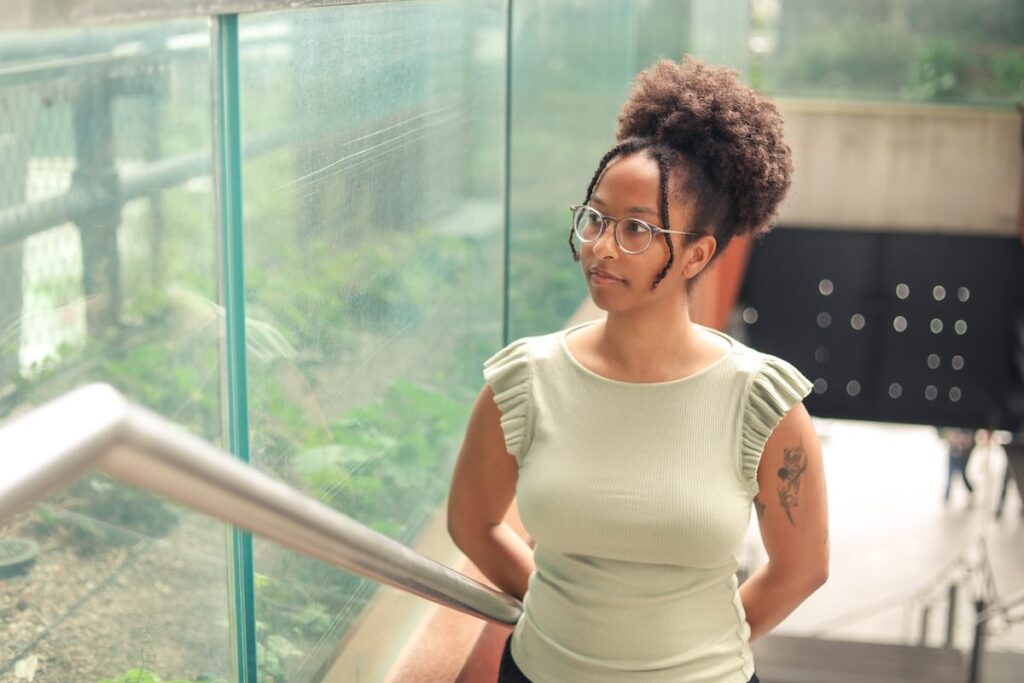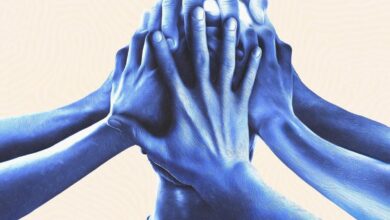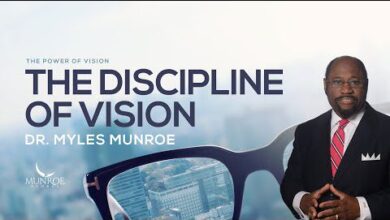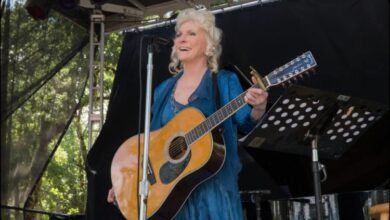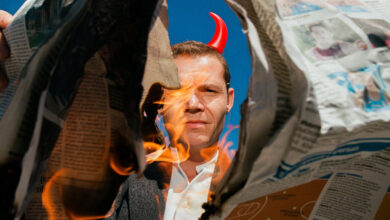The work of Canadian composer and scholar Corie Rose Soumah is as vast as the natural world. Guided by Afrodiasporic geologies, her physical and visceral music shapes the sounds of what’s in the sky, on the surface, and deep below to the earth’s core, the innermost geological layer. But her approach is specific. Soumah doesn’t engage the natural world just because it’s beautiful, but because it’s worthy of excavation – because it tells the hardened stories of buried truths.
Her influences also include Korean dramas. The TV genre, Soumah said in an interview with Saad Hadad, is the most consistent thing in her life and a reference point for compositions such as SPINNING, TOUCHED, UNDREAMT; SNOW- (2022). As Soumah connects to the past while rooted in the present, it’s not about the things that are fractured within her or the many people of the African diaspora, but what is most consistent.
Soumah also stands firmly against being used to fill a program merely for representation, having turned down commissions for this reason in the past. Her music – what she’s communicating – is for study, not just for show. There is no filler in her intentionally crafted compositions, and likewise, she won’t be used as filler on a concert with no clear reason why her presence, and life, really matter.
As part of the 2025 TIME:SPANS festival, the International Contemporary Ensemble will give the U.S. premiere of Soumah’s work Tossed Parachutes of Lilacs and Lungs (2025). We caught up with her to discuss the new work, her collaboration with the ensemble, and her compositional process.
How much of Tossed Parachutes of Lilacs and Lungs reflects where you’ve been and where you’re going as a composer and a scholar? What approaches or sounds are you experimenting with in this work?
Tossed was first and foremost a piece that I felt rather than heard, which surprised me as I tend to hear the core end of each and every piece I have written as the first sonic element in my compositional process. At the time of writing this work, something quite spiritual was happening with my relationship with time, routines, and small unrelated musical habits. It was both eerie and soothing at the same time. Because those feelings are so volatile and without boundary, it was important for me to musically go back to a space where multiple states of imagery are possible. To my ears, this work investigates places and on being. This piece is as much an interest in the mundane as an exploration of growth through spirituality, in the bell hooks sense of it. To do so, the five tableaux in Tossed act as windows on different senses related to the body and personal wonders in relation to my quotidien. This includes sounds that have been healing to me since I was a child, such as the Kora and poetry from Nicky Beer.
I think I simply used to be worried about sounds being too “irrational,” and about presenting them without a proper form in which the listener wouldn’t be able to sense their evolutions. Now after all those years worrying about such trivial matters, I simply don’t bother to write music that is “rational,” whatever it meant for me at an earlier stage of my artistic life. This piece encapsulates all of the latter: the pressing, the body, the spiritual and the volatility.
“I’m interested in shaping contrasts that have no interest in blending together in order to create some sort of internal movement, breaking uniformity.“
During the process of preparing this new piece with the International Contemporary Ensemble, what new perspectives did you pick up about collaborations, or what old perspectives did you have to put down?
The collaboration with ICE was quite straightforward, in the sense that the work was commissioned, written, and then delivered to the ensemble — they recently performed it for the first time in Darmstadt. That being said, I tremendously enjoy hearing the sound of an ensemble before writing anything and listening as much as possible beforehand to their repertoire. Since their documentation is so extensive, I was able to travel between sound worlds, which gave me the courage to do so as well in my own work.
Despite this more traditional approach to collaboration, I always think of the score as a way to enhance the personal voices of the musicians involved. Notational hybridity in scores is an artistic process that I value very much. It can visually and sonically display more freedom for sculpting sounds for the performer, accessing their personal ability to build complex textures. In Tossed, each movement has its own little graphical elements, shared amongst the musicians. In addition, my pieces are often a collection of different interactions from previous collaborations. For Tossed, I was very privileged to be able to workshop some of the sounds with previous collaborators such as Jay Sorce from Hypercube — the end of the piece wouldn’t have been possible without his advice concerning the electric guitar part, (extremely grateful for it)!
What does it mean to compose from the perspective of Afrodiasporic geologies? And how does that influence the style, sound, techniques or instrumentation of your work?
Afrodiasporic geologies is a term that I defined after reading the book A Billion Black Anthropocenes or None by Kathryn Yusoff. This book was life changing for me because it encapsulated multiple concepts surrounding ecology and colonialism that I was already familiar with. Basically, Yusoff traces the intrinsic link between the concept of white settler geological language and the destruction of lands, ecosystems, communities, and forced displacement throughout history. While I was reading it, I wondered what a counter concept to this geological process could be, which to me would imply no-boundaries for a multiplicity of forms of being and existing throughout human and non-human entities, i.e. Afrodiasporic geologies. In some of my other works, this concept is put out more straightforwardly (with vibrating shells or references to Antarctica). In this case, it has to do with the impulse to shape moments singularly different from one to another. I’m interested in shaping contrasts that have no interest in blending together in order to create some sort of internal movement, breaking uniformity.

Are there musical languages you want to learn (or unlearn)? What are you gravitating towards, or what is pulling you in against your will?
I used to be more interested in extreme short forms — and still today, to me, they are the most difficult ones to achieve! My relationship with longer form pieces has dramatically changed in the last few years, and I’m leaning more toward expanding whatever is in front of me, despite the length of the piece. It’s interesting to me because this longing for longer gestures forces me to make more drastic decisions in shorter pieces, and I believe this process of constricting the musical thoughts helps with the clarity of the work in the end. The only thing I am still unlearning is to not be afraid of showing what obsesses me, even if it can sound silly. The best works to my ears are those who are not afraid to show what they are obsessed with. This is what I like about being an artist and experiencing other people’s art.
Musical languages are often racially defined, and you’ve mentioned that people often assume you’re drawing from jazz influences despite the fact that it’s never been your school of study. How is your relationship to contemporary classical and Afrodiasporic musics impacted by expectations of you?
I grew up listening more to musicians like the Kora Jazz Trio, Diego el Cigala, Charles Aznavour, and Nina Simone than classical music, so to me it’s not surprising that some of those sounds are present in what I do — I discovered classical music and contemporary music more in-depth quite late compared to some of my peers when I was studying piano performance. It’s quite simple to me: contemporary music changed my life, as did everything that I listened to beforehand that I love. It’s a big part of why I want to do music, and I have no interest in hiding any of those connections. I believe that my music is much more complex than one category in itself because I like to collage so many influences in one, whether it be acousmatic music, Senegalese children singing, or Sciarrino influences.
In my undergraduate years, I found it deeply wounding to hear disappointed comments about a lack of jazz perspective in my work (or needing to think about my roots) when I wasn’t even trying to do anything related to it. Today, I find it more amusing when people are ascribing my music to a genre that would fit “what I look like” as a Black woman, which simply shows me that they haven’t bothered listening at all. In the end, I just want to do something meaningful and I hope this can come across to the listener.
I CARE IF YOU LISTEN is an editorially-independent program of the American Composers Forum, and is made possible thanks to generous donor and institutional support. Opinions expressed are solely those of the author and may not represent the views of ICIYL or ACF.
You can support the work of ICIYL with a tax-deductible gift to ACF. For more on ACF, visit composersforum.org.
